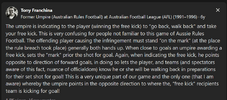NMBB
Norm Smith Medallist
- May 3, 2021
- 8,412
- 13,665
- AFL Club
- Collingwood
East Kew used to be a bit of a mini Cwood pocket - upwardly mobile people had moved up the Studley Park hill - couldn't afford Kew proper so settled for East Kew - it's a well located spotYes, Dunnings. Now the site of the Harp carpark and Stephen Silvagni's coffee shop.








